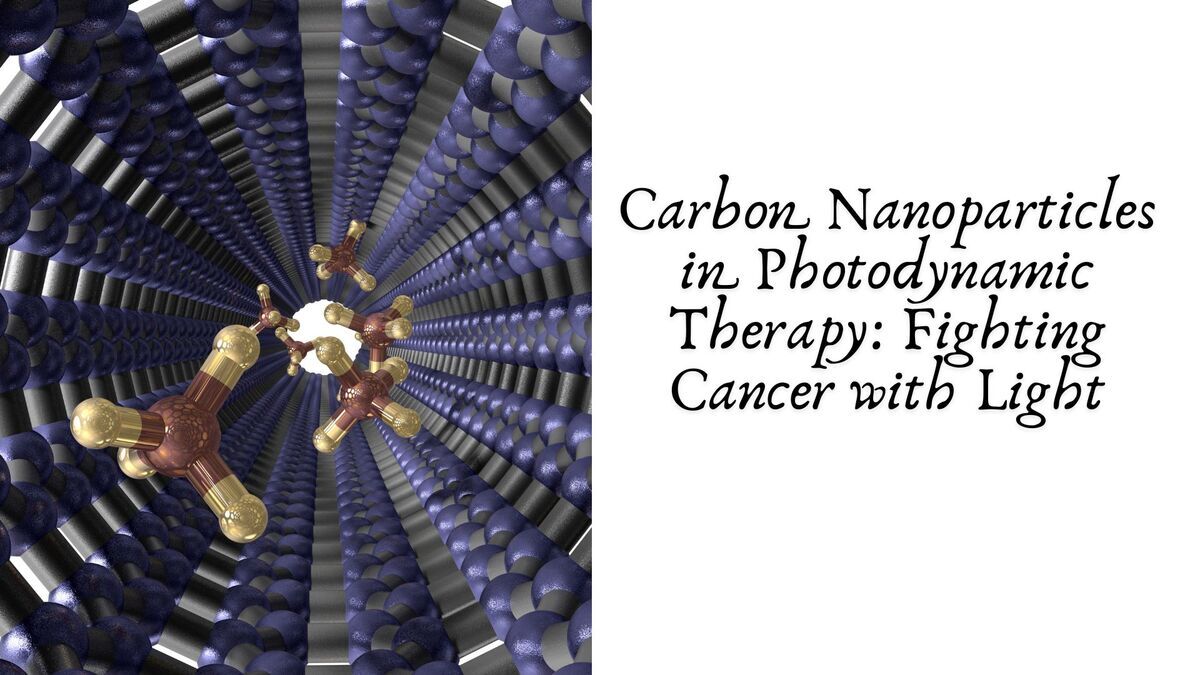
Carbon Nanoparticles in Photodynamic Therapy
- Book My Author
- Business
- 2025-09-21 17:57:19
- 853K
Cancer remains one of the most formidable health challenges of the 21st century. Despite significant advancements in chemotherapy, radiation, and immunotherapy, many treatments often come with severe side effects, high costs, and limited effectiveness for certain types of tumors. As researchers search for more targeted and less invasive solutions, photodynamic therapy (PDT) has emerged as a promising treatment modality. Among the various nanomaterials explored to enhance PDT, carbon nanoparticles (CNPs) have gained remarkable attention due to their unique physicochemical properties, biocompatibility, and ability to work synergistically with light-activated processes.
This article explores how carbon nanoparticles are revolutionizing photodynamic therapy and their potential to redefine the fight against cancer.
Understanding Photodynamic Therapy
Photodynamic therapy is a minimally invasive treatment that uses three key components:
- Photosensitizer (PS): A light-sensitive compound that generates reactive oxygen species (ROS) when exposed to light.
- Light Source: Usually a laser of specific wavelength that activates the photosensitizer.
- Oxygen: Present in the surrounding tissue, oxygen interacts with the excited photosensitizer to produce ROS such as singlet oxygen, which can damage cancer cell structures and induce cell death.
PDT offers advantages such as tumor selectivity, minimal systemic toxicity, and the ability to preserve surrounding healthy tissues. However, traditional PDT is limited by the poor solubility of photosensitizers, low tumor accumulation, and limited light penetration. This is where carbon nanoparticles step in as powerful allies.
What Makes Carbon Nanoparticles Unique for PDT?
Carbon-based nanomaterials, such as carbon dots (CDs), graphene quantum dots (GQDs), fullerenes (C60), and carbon nanotubes (CNTs), have properties that make them particularly suitable for PDT applications:
- Enhanced Photostability: Unlike conventional photosensitizers, carbon nanoparticles resist photobleaching, allowing prolonged therapeutic action.
- Tunable Optical Properties: Their fluorescence and absorption characteristics can be adjusted for near-infrared (NIR) activation, enabling deeper tissue penetration.
- Biocompatibility: Carbon nanoparticles often exhibit low toxicity and can be functionalized with biocompatible coatings.
- Targeted Delivery: Surface modification allows attachment of tumor-targeting ligands, peptides, or antibodies.
- Dual Functionality: Many carbon nanoparticles act as both photosensitizers and drug carriers, combining PDT with chemotherapy for enhanced results.
Mechanisms of Carbon Nanoparticle-Assisted PDT
Carbon nanoparticles contribute to photodynamic therapy in several ways:
Direct ROS Generation
Certain CNPs, like graphene quantum dots and fullerenes, can directly produce singlet oxygen under light irradiation, eliminating the need for external photosensitizers.
Photosensitizer Carriers
Carbon nanotubes and graphene sheets can load and deliver traditional photosensitizers to tumors, improving their solubility, stability, and tumor selectivity.
NIR-Activated Therapy
Carbon dots engineered for NIR excitation allow treatment of deeper-seated tumors by overcoming the shallow penetration of visible light.
Synergistic Therapies
CNPs can combine PDT with photothermal therapy (PTT), where absorbed light is converted into localized heat, creating a dual attack against cancer cells.
Recent Advances and Applications
Carbon Dots in PDT
Carbon dots are small, fluorescent nanoparticles with excellent water solubility. They have been developed as intrinsic photosensitizers or as carriers for other PS molecules. Studies show their ability to generate ROS and target tumors efficiently due to their nanoscale size and biocompatibility.
Fullerenes (C60) for Singlet Oxygen Production
Fullerenes exhibit strong photochemical properties, producing singlet oxygen efficiently under visible light. Modified fullerenes have demonstrated significant cancer cell-killing effects in vitro and in animal models.
Carbon Nanotubes for Drug-Photosensitizer Delivery
Single-walled and multi-walled carbon nanotubes serve as multifunctional platforms. They not only deliver photosensitizers to cancer cells but can also absorb NIR light for combined PDT/PTT, offering higher therapeutic efficacy.
Graphene Quantum Dots
Graphene quantum dots show promise due to their stable fluorescence, easy functionalization, and ability to cross biological barriers. When conjugated with targeting molecules, they significantly improve PDT precision.
Benefits of Using Carbon Nanoparticles in PDT
- Higher Selectivity: Functionalization allows tumor-specific targeting, minimizing damage to healthy tissues.
- Reduced Side Effects: Lower systemic toxicity compared to conventional chemotherapy.
- Deep-Tissue Treatment: NIR activation extends PDT applications beyond superficial cancers.
- Theranostic Capabilities: Many CNPs can serve both as diagnostic imaging agents and therapeutic tools, enabling real-time monitoring.
- Multimodal Therapy: Integration with photothermal therapy, chemotherapy, or immunotherapy enhances overall cancer treatment outcomes.
Challenges and Considerations
Despite exciting advancements, several challenges must be addressed before widespread clinical application:
- Long-Term Safety: The metabolism and clearance of carbon nanoparticles remain under investigation. Accumulation in organs could pose risks.
- Standardization Issues: Variability in synthesis methods leads to differences in particle size, surface chemistry, and therapeutic effectiveness.
- Regulatory Barriers: Clinical translation requires rigorous testing for biocompatibility and toxicity.
- Light Penetration Limitations: While NIR activation improves depth, treating very deep-seated tumors remains difficult.
Future Directions
The future of carbon nanoparticle-assisted PDT looks promising, with research focusing on:
- Hybrid Nanoplatforms: Combining CNPs with metallic or polymeric nanoparticles for multifunctional cancer therapy.
- Smart Targeting Systems: Designing stimuli-responsive nanoparticles that release drugs or activate only in the tumor microenvironment.
- Integration with Immunotherapy: Leveraging PDT-induced immune responses to synergize with checkpoint inhibitors and vaccines.
- Personalized Medicine: Using patient-specific tumor profiling to tailor nanoparticle-based PDT strategies.
Conclusion
Carbon nanoparticles are opening new horizons in photodynamic therapy for cancer treatment, offering precision, efficiency, and reduced side effects. With their ability to generate reactive oxygen species, carry therapeutic payloads, and function under NIR activation, CNPs present a transformative approach to fighting cancer with light. While challenges regarding safety and clinical translation remain, ongoing research continues to bring this technology closer to real-world application.
In the coming years, the marriage of nanotechnology and photomedicine may well redefine how we fight cancer—turning light into one of the most powerful weapons against the disease.









